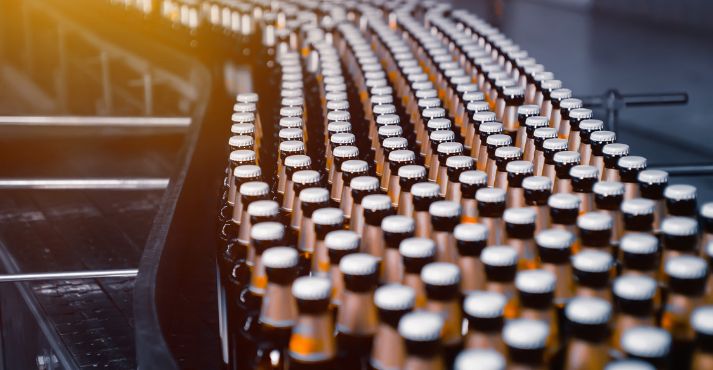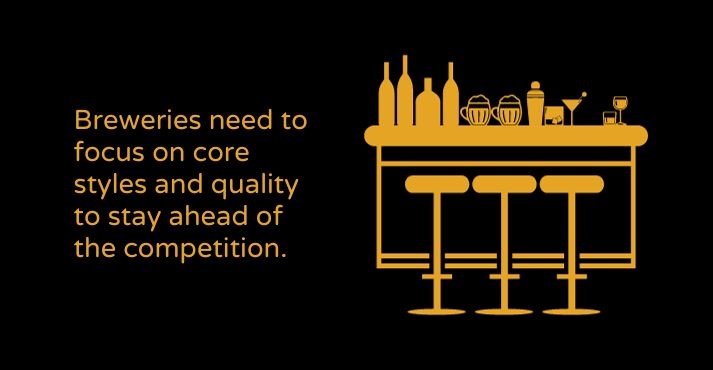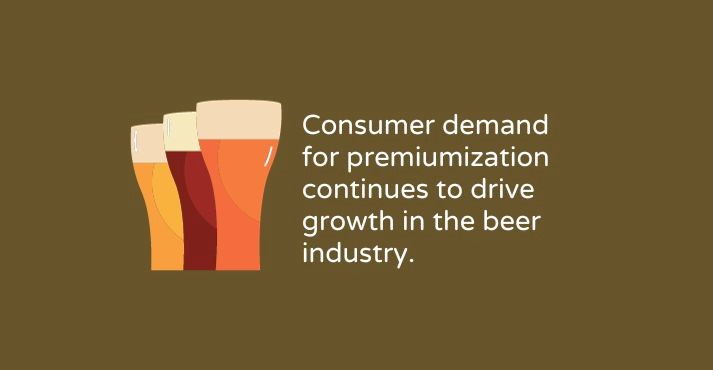Our way of living today differs from a few years ago.
While the pandemic remains a recent memory, the beer industry faced a wave of challenges, such as supply chain disruptions, spiking prices, increasing inflation, and a tight labor market. These challenges have resulted in dynamic beer industry trends.
So, what’s going on with the beer industry? Consumer behavior is drastically changing. The key lies in understanding the landscape shift and looking closely at trends that will transform the beer industry in 2024 and beyond.
9 Beer Trends to Watch in 2024

The beer industry is set for significant growth amidst market uncertainties. With glimmers of hope and increasing demand, watch out for the trends and discover the benefits of attending the F&B exhibition for your beer business to get deeper insights.
With that in mind, let’s explore the top beer trends 2024.
1. Increased Demand for Higher ABV
As we dive into beer markets’ insight, the bold, boozing, and warming high-ABV beers are the new hot items on the bar menu. These high-ABV beers have become a favorite among beer enthusiasts looking for bold and unique drinking experiences.
Higher Alcohol by Volume (ABV) beers are brews that contain a more significant percentage of alcohol compared to standard beers. While standard beers typically have an ABV of 4% to 6%, high-ABV beers can exceed 10% and sometimes even go beyond 15%.
2. Breweries Focusing on Core Styles and Quality

Change is constant. Increasing competition for shelf placement has made breweries focus on differentiation. And hence, breweries are getting recognition through beer awards for their diversity and creativity.
Consumers enjoy a wide variety of beers while the pressure builds up on breweries to develop new, original beer flavors continuously. The reputation of brewers now relies on their consistency to deliver a product that satisfies consumers and builds a sensory profile for your brand.
Also, breweries are simplifying their beer offerings, trimming slow-selling brands, and emphasizing core styles to enhance profitability.
3. Breweries Found Alternatives to Carbonating Beers
One more notable trend in the beer industry that has emerged to explore alternative methods for carbonating their brews.
Natural carbonization is an alternative that has gained traction as it occurs through the fermentation of alcohol alongside water’s natural absorption of carbon dioxide. These alternatives will result in an unrestricted supply and production of drinks.
Another popular alternative is nitrogen, which creates a smoother texture with fine bubbles. Also, from the commercial point of view, nitrogen helps you save huge costs, as on-site nitrogen production eliminates supply chain problems.
4. Beer Brands Becoming More Eco-Friendly
Consumers are shifting their spending towards eco-friendly products and trying to take some action to live sustainably.
According to the research conducted by McKinsey & Company and NIQ, products making ESG-related claims have averaged 28 percent cumulative growth over the past five-year period.
With innovation in sustainable food packaging, beer brands are also becoming more eco-friendly. For a better-for-the-environment alternative, some breweries are focusing on using bio-based and compostable eco paperboards as an alternative to plastic.
Also, incorporating sustainable equipment in the brewing process will reduce waste and save energy.
On a larger scale, this trend has prompted breweries to adopt environmentally friendly production methods, such as reducing water usage, using renewable energy sources, and implementing recycling programs.
5. More Local Beers
The global economic and pandemic crisis has spurred the demand for more local brewers. With a rising demand for local flavor and fusion diversity, the Asia food and beverage statistics showcase a growing mix of local and international brands. The popularity of local beers can be attributed to unique experiences, distinct tastes, concerns about sustainability, and an emphasis on supporting local businesses. These factors have fueled the growth of local beers over mass producers.
6. Breweries are Adopting Digital Marketing
The beer market is enormous, and everyone, including baby boomers, millennials, and Gen Z, enjoys a pint now and then.
Breweries are adopting digital marketing to Increase restaurant brand awareness, expand customer reach, and increase sales. The pandemic has also played a vital role in shifting the breweries from traditional brick-and-mortar format to online stores.
Embracing digital marketing is cost-effective, as it helps them use social media, websites, and targeted ads to engage consumers to showcase new products, promote events, and, most importantly, gain data and analytical insight into changing consumer behavior in a dynamic market.

As inflation and economic uncertainties continue to bite, consumers are still willing to pay more for new beer styles and unique flavors. Premiumization means attention to flavor, high-quality ingredients, and more appealing packaging.
As the market dynamics evolve, people are more likely to treat drinks as something worth spending a little extra on. There is a preference for sophisticated indulgences and experiences.
Brewers must understand that it is a niche, and profitability can only partially depend on premium products in the beer industry.
8. Craft Beer Movement on the Rise
The craft beer revolution is here. Craft beer is a term used to describe beer produced by small and independent breweries known for their dedication to quality, flavor, and traditional brewing methods.
The factors driving the craft beer movement forward include demand for variety, higher disposal income, taste for flavor, and beer quality.
Companies like Beer Yard, Anchor Porter, and Anheuser-Busch are leading brands gaining popularity in the craft beer market. As more people seek out experiences, craft beer continues to capture beer enthusiasts’ hearts and taste buds worldwide.
9. Cold IPAs Still in Hot Demand
Cold IPAs continue to be in hot demand, captivating the palates of those seeking refreshing and hop-forward experiences. IPA beer is a style of pale ale that emphasizes hop flavors and aromas.
It blends the crispness of a lager with the bold hop character of an India Pale and creates a harmonized fusion of flavors.
Consumers who prefer fermented drinks at a lower temperature are demanding IPAs with refreshing and easy-drinking nature.
As long as beer enthusiasts seek exciting new tastes that challenge the conventional norms of brewing, cold IPAs will likely remain a hot commodity in the craft beer scene, satisfying the thirst for innovation and classic beer flavors.
Beer Industry Trends – FAQs
What are the threats to the beer industry?
Critical threats to the beer industry include:
- Health and wellness trends
- Regulation and taxation
- Competition from other alcoholic beverages
- Craft beer saturation
- Changing consumer preferences
- Economic downturns
- Climate change and resource scarcity
- Supply chain disruptions
Who is the target market for beer brewers?
The target market for beer brewers includes:
- Distributors and retailers
- Restaurants and bars
- Brewpubs and taprooms
- Beer festivals and events
- Homebrewers and brewing enthusiasts
- Export markets
- Local and regional markets
- National markets
- International markets
What are the sustainability challenges in the beer industry?
The beer industry is faced with several sustainability challenges, including:
- Water conservation
- Energy consumption
- Waste management
- Packaging materials
- Supply chain emissions
- Agricultural practices
- Biodiversity conservation
- Climate change mitigation
- Social responsibility
- Alcohol-related harm reduction
Closing Thoughts
As we end, it is clear that beer industry trends are transforming the business landscape for local and international players. While we can’t predict the exact future, navigating through the analytics, consumer behavior, and financial forecasts, we think we have the pulse on beer trends in the industry.
Moreover, to stay ahead of the competition, you can explore the latest trends in Asia’s food and beverage industry for 2024 and learn about the latest trends beer trends.
By understanding the beer industry holistically, you can enhance sales trends, foster growth, and enable the exploration of emerging opportunities within this dynamic market.













